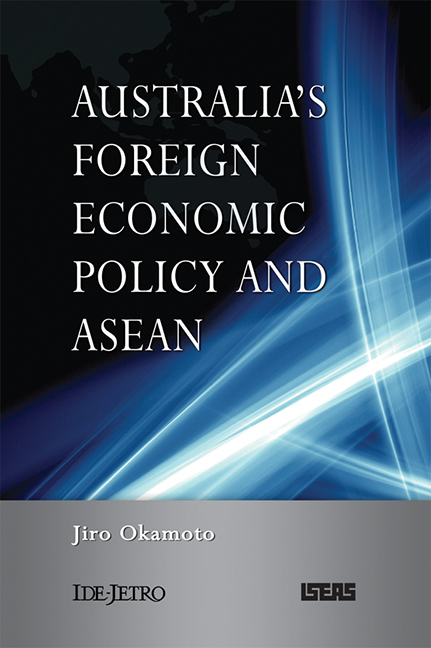Book contents
- Frontmatter
- Contents
- List of Figures and Tables
- Abbreviations and Acronyms
- Acknowledgements
- 1 Introduction
- 2 An Analytical Framework
- 3 State-Society Coalitions and Australia's Foreign Economic Policy
- 4 Australia and the Formation of ASEAN
- 5 The Trade Liberalizers and Asia-Pacific Regionalist Strategies
- 6 The Development of ASEAN Regionalism and the AFTA–CER Linkage Dialogue
- 7 The Bilateralists and their ASEAN Policy
- 8 Conclusion
- Appendix: Foreign Economic Policy-Related Ministers in Australia since 1941
- References
- Index
- About the Author
- Frontmatter
- Contents
- List of Figures and Tables
- Abbreviations and Acronyms
- Acknowledgements
- 1 Introduction
- 2 An Analytical Framework
- 3 State-Society Coalitions and Australia's Foreign Economic Policy
- 4 Australia and the Formation of ASEAN
- 5 The Trade Liberalizers and Asia-Pacific Regionalist Strategies
- 6 The Development of ASEAN Regionalism and the AFTA–CER Linkage Dialogue
- 7 The Bilateralists and their ASEAN Policy
- 8 Conclusion
- Appendix: Foreign Economic Policy-Related Ministers in Australia since 1941
- References
- Index
- About the Author
Summary
Australia's foreign economic policy1 has experienced a great deal of change since the early 1980s. So too has its policy towards the Association of Southeast Asian Nations (ASEAN). In the 1970s, Australia continued to reject ASEAN' demand for better access by its members for industrial exports to the Australian market. By the end of the 1980s, the Australian Government saw ASEAN as an integral part of an Asia-Pacific regional architecture, which was based on the concept of multilateral free and open trade and investment, and tried to work with ASEAN for that cause well into the 1990s. Since the start of the new century, Australia has been more inclined to give priority to bilateral relations with members rather than ASEAN as a whole, a move illustrated by the establishment of bilateral free trade agreements (FTAs) with some individual ASEAN members.
This book focuses on the development of Australia's foreign economic policy towards ASEAN and its members and tries to explain why it shifted as it did. It argues that the shifts in Australia's ASEAN policy have not only closely reflected the changes in Australia's overall foreign economic policy orientation since the 1980s, but that at times Australia's ASEAN policy strongly drove the change. The development of Australia–ASEAN relations illustrates the importance of the shifts in Australia's policy in sharp relief, as ASEAN has been a critical external actor in shaping the dynamics of Australia's foreign economic policy.
Australia's foreign economic policy, in turn, has been an important factor in explaining the development of economic cooperation in the Asia-Pacific region since the 1980s. For instance, Australia's regional economic cooperation initiative in the late 1980s culminated in the establishment of the Asia-Pacific Economic Cooperation (APEC) forum, which involves major countries on both sides of the Pacific. In creating APEC, Australia's initiative towards ASEAN and ASEAN' support for it were crucial. In recent years, while the “East Asian” economic integration has gained momentum following the 1997 Asian financial crisis (hereafter referred to the “Asian financial crisis”), Australia, whose inclusion in the regional integration process has remained ambiguous, has opted to negotiate bilateral FTAs to pursue its concrete economic interests. This bilateralist foreign economic policy, nevertheless, has not hindered Australia's regional engagement.
- Type
- Chapter
- Information
- Australia's Foreign Economic Policy and ASEAN , pp. 1 - 16Publisher: ISEAS–Yusof Ishak InstitutePrint publication year: 2010



